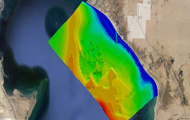Near Shore Morphodynamics at Ayoun Moussa
project2 title
project3 title
|
Our institute is one of the oldest in the Middle East and Africa to conduct research and offer consultancy services in water resources and hydraulics. We have a variety of facilities to support research projects. In HRI we can offer various research solutions matching your requirements and budget. We have a range of physical modelling laboratories, instrumentation and facilities that are equipped for Riverine, estuarine and Coastal studies. Based on agreements and conditions, we can provide access to our facilities for researchers and users from the outside. We use a variety of numerical modeling tools and packages that can support your study requirements. We also have the tools and instrumentation to carryout field survey campaigns and collect both short and long-term data collection studies. There are also facilities to calibrate current-meters. Below is a further detailed list on the tools available: Experimental Halls and FlumesHRI has three main experimental halls, two of them are used for the construction of large scale physical models, mostly for riverine studies. The third hall is equipped with a wave generator which is set for coastal and estuarine studies. Three flumes exist and are typically used to study forces on gates, protection layers around structures, and sediment mobility studies. Nonetheless, these flumes can be used also to study wave loading offshore structures, detailed analysis on the water movement over coastal protection structures. In the case where the main flumes are occupied, the large scale experimental halls have enough space and equipment to have additional flumes built within, which have been the case several times in the past. There are also two flumes –straight and annular– dedicated for the calibration of current-meters. The experimental scale models have been used in a multitude of studies including, sedimentation problems around water intakes, dams, regulators, barrages, culverts, and jetties. They have also been used to study thermal plume dispersion, both in riverine and coastal environments. HRI is willing to collaborate in research that is focused on delta management and flood protection. The experimental halls and available equipment can offer a ground to study natural and anthropogenic processes in deltas. The experimental facilities available can allow for studies focused on fluvial and coastal interactions. The evolution of landforms wave action, change in base level (mean sea level) and fluvial flow processes can all be incorporated in physical models. If you have any questions, inquiries, or have something interesting you would like to test please contact us at info@hri-egypt.org Field Survey EquipmentHRI has a long history carrying out long term field measurements and dedicated field survey campaigns. A range of equipment are used in field campaigns including differential GPS, ADCP, data loggers, suspended sediment and bed grab samplers. The institute has three mid-size research vessels, in addition to two rubber-motor boats. The institute depends on a team of skilled technical assistants survey team is equipped with tools and safety gear required for such missions, in either marine or riverine environments. The institute also developed a total load sediment sampler in collaboration with Delft Hydraulics (Deltares) to measure bed and suspended sediment loads in sand bed rivers. The sampler was tested and developed under a range of conditions initially in the lab and in the field (Nile River). The sampler is equipped with an underwater video camera and can be used to measure the loads for a range of sediment sizes. Sediment LaboratoryThe sediment lab at HRI is equipped to carry sieve analysis via wet and dry sieving, and total suspended solids. An autoclave is used to dry the samples, which is typically used to allow our scientist to obtain the dry density of a sample. The lab can also analyze sediment cores extracted at sites for depositional systems, such as at river mouth, point bars and river banks. Numerical ModelsNumerical models are ubiquitously being used to address engineering and science problems. At HRI, numerical models are used to simulate natural processes in shallow waters, including fluvial, estuarine and coastal processes. This is also in addition to human induced processes such as environmental flows, hydro-morphological changes resulting from the construction of dams or power plant cooling systems, etc. We use these models to allow us to make predictions for future changes whether they occur naturally or through anthropogenic interventions. The model selection process suitable for a study depends on the processes involved and the objectives of the study.
Our scientist’s at HRI have a strong modeling background with hands on and training on a variety of models. These models include: WorkshopHRI has a main workshop in which wooden and metal works needed for physical modeling research projects can be manufactured. The work is carried out by a highly skilled group of craftsmen technicians, and labors, working as a team to produce different parts of hydraulic structures for the models. Information Technology ServicesThe institute has an IT group which administrates our computer network. Equipped with a computer lab. The IT group is responsible for the management of our database including archiving of technical reports and collected data, and managing software packages. They also help in formatting and finalizing the outputs of technical and secretarial work. Technical LibraryHRI has a library containing a large collection of periodicals, journals, technical reports in all the different fields of our specialty. Some of the archived technical reports comprise valuable data and research work that can dates to 1930’s when the institute started as a research experimental station. |